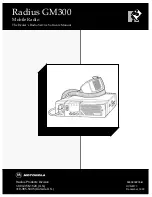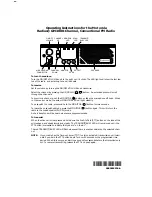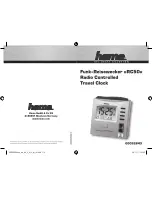
Page 7
For assistance, call RITRON at 1-800-872-1872, or go to < http://www.ritron.com >
qtm9322b.pm5
TEST YOUR SWITCH'S OPEN AND CLOSED CONDITIONS
4. Activate your switch; listen to your two-way radio as
the factory default messages are transmitted. (The
message will be either "Switch One Open" or
"Switch One Closed".)
Write down a description of how the condition of
your switch corresponds to the transmitted mes-
sage. Then deactivate the switch and listen to the
other transmitted message; again, write down the
results.
5. From performing Step 4, above, you should under-
stand how your switch works, and the meaning of its
open and closed states — essential knowledge to
program a descriptive voice message for each
switch condition.
For example, if your switch is a magnetic reed
switch on a door, and the switch closes when the
door is opened, you can record the phrase "Door
three open" for the switch closed condition, and then
"Door three closed" for the switch open condition.
Note that magnetic reed switches are available
which work in the opposite way.
NOTE: We suggest that you do not record over the
factory prerecorded messages until you are
sure how your switch works. If the factory-
programmed messages have been erased,
you will have to use an electrician's continuity
tester or similar instrument to determine
how your switch works.
What is the purpose of testing my switch? In Quick
Talk's basic operating mode, you may record two (2) voice
messages for the Quick Talk to transmit. One message is
transmitted when the switch is Opened and the other is
transmitted when the switch is Closed. Each message
must be eight (8) seconds or less in length.
Before you record these switch condition messages,
determine how your switch works by using the factory
prerecorded messages in the Quick Talk. After you have
programmed the Quick Talk with your radio system
frequency and with any required sub-audible squelch
codes, use the following procedure.
Do I need to test my switch? If you are certain of the
conditions which cause your switch to open and close, you
do not need to perform this test. However, we recommend
you do test your switch, because doing so will confirm you
have properly programmed the Quick Talk transmitter
frequency — and, if required for your radio system, the
Quiet Call Interference Eliminator squelch code.
To Test Your Switch and Verify Reception of Messages
by Your Radios
1. Remove the batteries from the holder.
2. Review the safety precautions on Page
ii of this
manual before connecting your switches. When
you are sure your connections will be safe,
connect your switch to the Quick Talk terminals
labeled Switch #1. See Figure 2 below.
3. Reinstall fresh AA Alkaline batteries in the Quick
Talk according to the polarity marks.
+
+
+
+
+
+
FIGURE 2: CONNECTIONS FOR TESTING YOUR SWITCH
C
ONNECT
THE
STANDARD
MODULAR
PLUG
ONLY
TO
A
TELEPHONE
SET
.
D
O
NOT
CONNECT
IT
TO
A
TELEPHONE
LINE
.
1
Antenna Connection
(Antenna shown on page 12.)
3
Battery Holder
CONNECT TO
SWITCH #1
TERMINALS.
(Back of Quick Talk Cover Assem.)
+
—
SWITCH 2
+
—
SWITCH 1
+
—
EXT. PWR.
F
ACTORY
S
HORTING
J
UMPER
(Enables Quick Talk; see page 11.)
Owner Supplied Standard
Desk Telephone, switched to
Pulse Dialing Mode
TO
Q
UICK
T
ALK
TELEPHONE
JACK
































